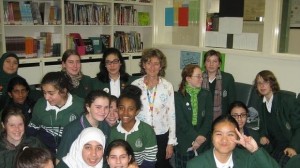A literacy teacher, who has watched students read the first chapter of many books but never finish one, has written her own teen novel, hoping this will be the one the students finish.
“Once they have read one book, they’ll read another.”
June Laurie, literacy co-ordinator at Pascoe Vale Girls Secondary School, has taught at primary and secondary schools for more than 20 years and says about one third of students who arrive in year 7 are reading at grade 3 or 4 level.
And, according to Ms Laurie, there are many secondary school students who have never managed to finish a book. Not one.
“They read the first chapter of many books,” she says.
Now, she’s trying to change that one-chapter-many-times-over experience with a book she’s written aimed at both reluctant readers and students of low literacy.
The self-published book Blake Collider – Into Thin Air is the tale of a 16-year-old bored misfit who goes on an exchange program to Italy and gets caught up in romance and a physics experiment known as the Hadron Collider project.
It has particle physics “string theory” research at its heart and, despite being written by a non-scientist, has a focus on some quite sophisticated science.
Readings’ review describes it as “a page-turning romp through Italy, neo-Nazism and dimension travel. A love story with a twist of physics, ethics and Italian!”
The book has been bought by several schools across the state including Williamstown High School, Essendon Keilor College and her own school, Pascoe Vale Girls’. She says while the novel is also engaging and interesting for confident readers, Blake Collider is particularly aimed at those low-literacy or reluctant readers. Ms Laurie says the key to engaging these students is to “keep the plot structure simple but the action engaging.”
“Most of the books promoted for teenagers, such as The Hunger Games, are too complex in their plots,” she says. And when those complex plots cause reluctant or struggling readers to stumble and stall, they just give up – often at the end of the first chapter.
Ms Laurie says the best way to improve student literacy levels is to get children reading, and backwards-and-forwards plots don’t help that. “We learn to read by reading.” And once children have learned to read, students need to keep reading. “Research tells us that if students stop reading, they actually lose skills they might have acquired. Years 7 and 8, then, are crucial years to keep students reading.”
But where does it all go so wrong in the first place? Much of the focus on literacy is on difficulties children with dyslexia have but Ms Laurie says her experience teaching lower primary grades reveals a more complex mix.
She says around grade 1 and 2, when students are starting to become literate, many start borrowing books and developing the “reading resilience” that is crucial to becoming a strong reader. These young readers start persisting with difficult words and finishing books; they are on their way.
By contrast, also around this time, it also becomes clear that in any classroom some students have a “major learning difficulty” and some will have “missed a lot of schooling at a crucial stage”. Ms Laurie says it becomes evident in early secondary school, if not before, that some students’ reading is hampered because they have missed some crucial learning such as blends, “igh” and “ough” which make fluent reading harder.
It is these students who can reach years 7 and 8 never having finished a novel but with secondary schooling ahead of them, the reading and finishing of books only becomes more important.
Ms Laurie says there is no magic to helping students read but making books interesting and engaging is a start. And the goal is always the same: “to finish a book”.
Blake Collider is stocked at Melbourne Museum, Readings Carlton and from the author blakecollider@yahoo.com
